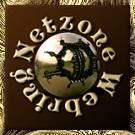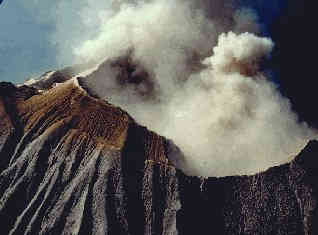![]()
Coasts
Rivers/Lakes
Lowlands/Plains
Geysers/Mud
Glaciers
Mt. Ruapehu
Mt. Cook
White Island
A Maori Legend
![]()
Abbotsford
Aramoana
Ballantynes
Brynderwyns
Cave Creek
Hawkes Bay
H.M.S. Orpheus
Influenza
Mt. Erebus
Mt. Tarawera
Rainbow Warrior
Seacliff Hospital
Tangiwai
Wahine
![]()
Annie Aves
Ata-hoe
Daisy Basham
Jean Batten
Minnie Dean
Mabel Howard
Margaret Mahy
Kath Mansfield
Kate Sheppard
Kiri Te Kanawa
Catherine Tizard
Murray Ball
Charles Goldie
Edmund Hillary
Richard Pearse
Lord Rutherford
Charles Upham
![]()
NZ FAQ--Funny
NZ Links
Credits
Does the idea of strolling around the steaming crater of a very live, at times hyperactive volcano appeal? White Island was born over two million years ago and is one of the most active volcanoes in the world. It steams, fumeroles belch, the crater is continually pushing out showers of ash and thermal activity occurs constantly. Scientists rush to monitor the action and tourists flock to the island to walk within the kilometre long main crater which is only a few feet above sea level. White Island is approximately 6 kms in circumference and positioned just off the Bay of Plenty coast. It was named by Captain Cook who said "it always appeared to us". The Maori name of Whakaari means 'to make visible'. Maori mythology says that back in the times when mountains walked, talked, loved and fought, two sister mountains, Whakaari and Motuhora lived on the Huiarau Range. One night they broke away and pushed down to the sea they had always wanted to visit. As they went Whakaari gouged the bed of the Whakatane River, and Motouhora, being tall and slim, formed the narrow gorges of the Waimana River. Feeling hungry, the plump Whakaari sent her sister to find food while she kindled a fire. Suddenly Whakaari saw the first flush of dawn and, knowing that when the sun's rays touched her they would transfix her to the spot forever, she fled out to sea. Motuhora returned to find her sister gone. Furious, she picked up a blazing log and chased after her. The sun's rays caught the pair before Motuhora could reach her sister, and with all her remaining strength she hurled the blazing log at Whakaari. So it was that fire came to the volcano and so it is that Motuhora (Whale Island) is much closer to shore.
For a number of years sulphur deposits and gypsum were mined from the island. It was not easy to get workers to stay on the island and it is recorded that one potential employee took one look at what greeted him and lashed himself to the mast of the boat, refusing to disembark until the boat returned to the mainland. In 1913 a sharp increase in volcanic activity commenced. This peaked on the 10th September, 1914 when an unexpected explosion caused a landslide which buried the entire mining settlement leaving no trace of the 12 people who had been living on the island, or their buildings, which were buried under metres of mud and rock. The one remaining life was that of Peter the Great -- the camp cat. Some later unsuccessful attempts were made to mine the sulphur deposits, but in 1934 White Island was declared a private scenic reserve and bird sanctuary. The ruins of one of the factory buildings can still be viewed on the island. Until 1968 Maoris were permitted to go out and catch muttonbirds and often caught between 200-300 a day, but these are now protected. White Island has the largest gannet colony in the country and the common house sparrow, native grey warblers, thrushes, starlings, terns and blackbirds are also found there. The waters close into the area can become extremely hot with fishermen reporting lead weights on their nets coming up melted after they drifted over vents. Others have claimed they have pulled up precooked fish. Birds bathing in the highly acidic waters on the island have been observed with feathers stripped to their shafts. There is no fresh water available. Attempts have been made to establish a monitoring device and early warning system on White Island, however earth tremors frequently put it out of operation. As a result the activity at the volcano is now monitored by Civil Defence officers. Should a major eruption ever occur the resulting seismic wave could quickly devastate low-lying areas of the Bay of Plenty. The owner readily gives permission for scientists and other interested parties to visit and it is a volcanologists paradise being so readily accessible and requiring little or no climbing. For visitors White Island holds the threat of death. Explosions occur several times a year, these are without warning. Flying rocks of one metre in diameter are common and if one of these hit someone it would definitely kill. Wind changes cause stinging and blinding ash or gas-laden clouds to overwhelm walkers. Civil Defence note that, "Volcanic gases at White Island are discharged at high temperatures (100-800 degrees centigrade) so that anybody falling into a vent would be rapidly cooked, an unwelcome prospect when blundering about in a steam cloud with eyes shut against acid drops!" There are no plans to make money from the volcano and the owner only requires a $10 donation from each visitor to go to charity. Sorry, for those of you interested in owning your own volcano, there are no plans to sell!
|



